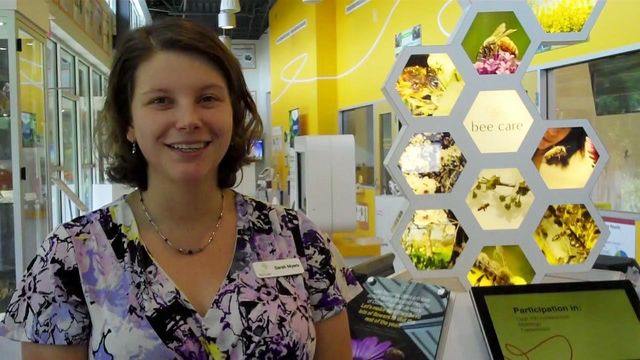Destination: North American Bayer Bee Care Center
September is National Honey Month, a celebration of that amber-colored, all natural food that sweetens our toast, cuts down on coughs and graces our soaps and lotions.
Posted — UpdatedSeptember is National Honey Month, a celebration of that amber-colored, all natural food that sweetens our toast, cuts down on coughs and graces our soaps and lotions.
Of course, we couldn't have honey without bees. And, without bees doing their job of pollinating plants, we couldn't have the fruits, vegetables and nuts we all need to survive.
Sarah Myers, a beekeeper and the center's coordinator of education and outreach, recently took me and my younger daughter on a tour. Since opening in April 2014, nearly 5,000 visitors have walked through the doors to learn more about bees.
Myers fell in love with bees as an N.C. State University student. The business major took a beekeeping course to fill her science requirement and found a new passion. Today, with her father, she also cares for 20 hives and sells honey in addition to her work at Bayer.
- Queen bees can lay up to 1,500 eggs a day.
- Each hive contains between 40,000 to 60,000 worker bees. And they're all female. They forage for nectar and pollen, build the wax and generally do all of the work.
- Bees will travel a one to three-mile radius to find food.
- Bees have their own "waggle dances," which direct other bees to the location of food sources.
The Bee Care Center also focuses on the Varroa mite, a pesky critter that attaches to honey bees and transmits disease, and efforts to kill it. There's a lot of research at Bayer related to the mite. The company has created a product that targets the pest.
(I would be remiss to not include here that there also is a lot of discussion and debate about Bayer's roll in bee health. The European Union has banned some pesticides that have been blamed on the death of honey bees - a ban that EU officials are now reviewing and which the United Kingdom partly suspended this summer. A Google search will pull up more articles about the topic with information from all of the sides involved.).
Related Topics
• Credits
Copyright 2024 by Capitol Broadcasting Company. All rights reserved. This material may not be published, broadcast, rewritten or redistributed.






